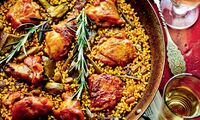Paella Valenciana
Paella Valenciana
A traditional Sunday dish from Valencia, often cooked over open fire. This version is adapted from Omar Allibhoy and based on the methods of Valencian chefs and home cooks.
Serves: 6
Ingredients
- 2–3 globe artichokes, cleaned and trimmed
- 1 g saffron
- 1 tbsp salt
- 8 tbsp Spanish olive oil (extra virgin)
- 400 g chicken pieces (on the bone; e.g. 2 thighs, halved)
- 400 g rabbit pieces (on the bone)
- 200 g runner beans, trimmed and cut into short pieces
- 100 g broad beans or fresh white butter beans
- 4 garlic cloves, finely chopped
- 1 large or 2 small tomatoes, grated
- 1/2 tsp sweet pimentón
- 2 l water or light chicken stock
- 500 g Spanish rice (such as calasparra or bomba)
- 1 sprig rosemary
Instructions
- Trim artichokes down to the hearts. Remove the fuzzy choke and rub the hearts with lemon to prevent browning.
- Wrap saffron in foil and toast it in a paella pan over medium heat for 30 seconds per side. Set aside.
- Raise heat to high. Sprinkle salt around the edges of the pan. When hot, add oil. Once it starts to smoke, add the chicken and rabbit. Brown well on all sides (about 15 minutes).
- Add runner beans and broad beans. Stir and cook 1 minute. Add garlic and cook 1 minute more. Add tomatoes, pimentón, and toasted saffron. Cook about 4 minutes, stirring often, until the tomato juice is mostly gone.
- Pour in the water or stock. Simmer for 20 minutes (or 5 minutes if using stock), scraping the bottom to release any browned bits. Adjust salt—it should taste slightly too salty.
- Cut artichokes into quarters and add. Add rice in an even layer. Stir once to distribute.
- Cook over high heat for 10–12 minutes. Reduce to low and cook another 5–7 minutes. Do not stir again.
- When liquid level drops below the rice, add rosemary. If the top layer looks dry, cover the pan with newspaper for the last 5 minutes to steam the top.
- Let rest 5 minutes before serving. The bottom should form a golden crust (socarrat).
Notes
- The dish should finish as a flat, even layer of rice.
- The socarrat (crispy bottom layer) is prized in traditional paella.
- Avoid stirring once rice has been added to maintain an even surface and allow proper steaming.
Source
Adapted from Tapas Revolution by Omar Allibhoy Video: https://www.youtube.com/watch?v=L_dDUw_QuDU Original article: https://www.theguardian.com/lifeandstyle/2015/jun/30/20-best-spanish-recipes-part-2-ofm-paella-seafood
Formatted to Recipe Style Guide on 12:11, 16 June 2025 (PDT) by ChatGPT

